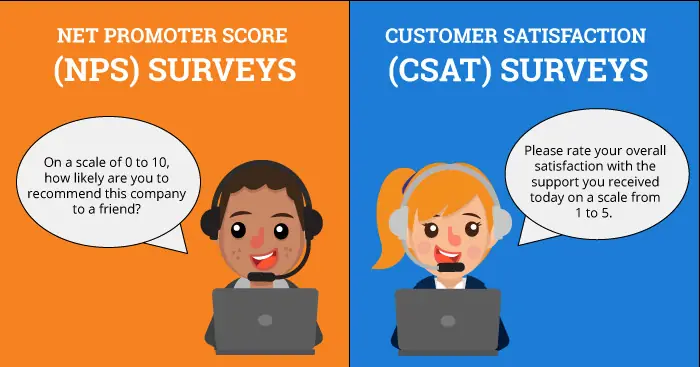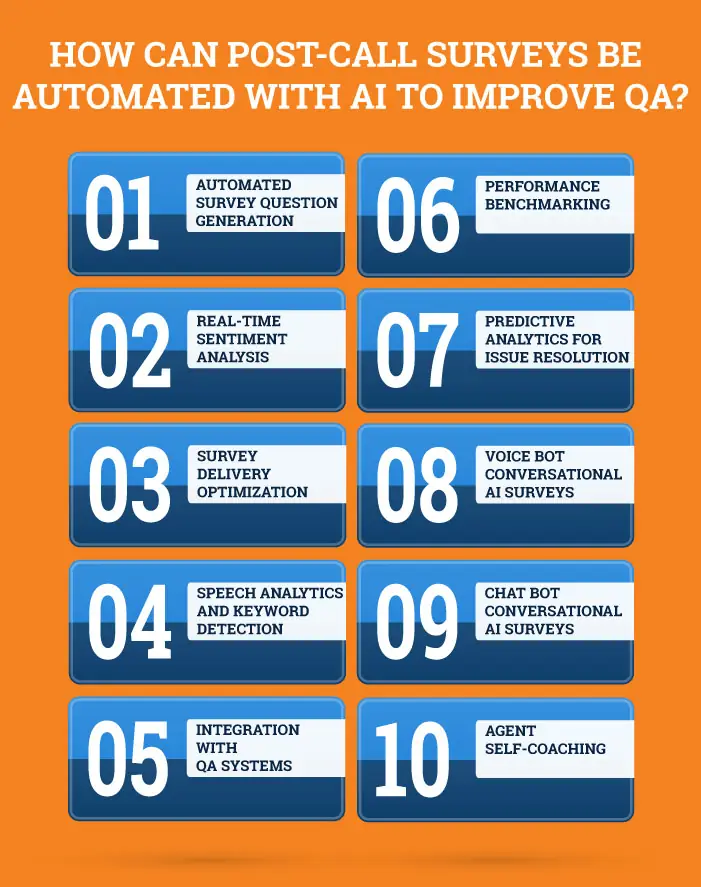What Are Post-Call Surveys?
Let's say you recently called a bank to discuss investment options, and the agent you spoke with on the phone was knowledgeable and explained your investment options clearly to you. You may have received another phone call right after the interaction or within one business day asking you to provide feedback on your recent phone call with that bank. This is called a post-call survey.
Post-call surveys are feedback mechanisms companies use to collect customer opinions and insights following interactions with their call centers or customer service departments. Live telephone survey agents are still conducting many post-call surveys; however, conversational IVR surveys will displace human method surveys in the near future.
The primary goal of these surveys is to evaluate the quality of the customer's experience and obtain feedback on various aspects of the interaction, such as agent performance, issue resolution, and overall satisfaction.
Post-call surveys often use rating scales and open-ended questions to measure Csat, customer sentiment, first call resolution (FCR), and to gather detailed comments. The data collected is analyzed to identify areas for improvement in customer service processes, agent training and coaching, and overall customer satisfaction.
These surveys are crucial in helping businesses refine their customer service, enhance the customer experience, and align their services more closely with customer expectations. They serve as a valuable source of actionable information that can lead to ongoing improvements and higher levels of customer satisfaction and loyalty.
Post-call surveys typically come in two primary types: Net Promoter Score (NPS) surveys and Customer Satisfaction (Csat) surveys. The most common is Csat surveys. It’s important to emphasize that most agents do not like the NPS metric because they feel that they have limited or no control over the NPS score.
- Csat surveys measure customers' overall satisfaction regarding a specific interaction or experience with a company. For example, customers are asked for feedback like this: "Please rate your overall satisfaction with the support you received today on a scale from 1 to 5. (1 = Very Dissatisfied, 5 = Very Satisfied)”
- NPS surveys measure customer loyalty and the likelihood of customers recommending a company's product or service to others. For example, customers are asked questions such as: "On a scale of 0 to 10, how likely are you to recommend this company to a friend or colleague? (0 = Not at all likely, 10 = Extremely likely)”

Why are Post-Call Surveys Important?
Post-call surveys are crucial for call centers because they serve as a direct feedback mechanism for customers. They help evaluate the quality of customer interactions, measure customer satisfaction, and identify specific issues or areas that require improvement. This feedback is invaluable for agent training, process enhancement, and maintaining a customer-centric focus, ultimately leading to higher customer retention rates and reduced churn.
Additionally, post-call surveys provide actionable data for benchmarking performance, driving efficiency, and showcasing a commitment to continuous improvement, all of which are essential for call centers to excel in today's competitive business landscape.
How Can Post-Call Surveys Be Automated With AI to Improve QA?
AI can be applied in various ways to automate post-call surveys and integrate with call center Quality Assurance (QA) processes. Here are some ways in which AI can be utilized:

1. Automated Survey Question Generation:
AI can automatically generate post-call survey questions based on customer interaction details. By analyzing call transcripts or call metadata, AI can create customized surveys tailored to the specific nature of the call, ensuring that the questions are relevant to the customer's experience.
2. Real-Time Sentiment Analysis:
AI-powered sentiment analysis can assess the sentiment of both the customer and the agent during the call. This analysis can trigger post-call surveys when significant shifts in sentiment occur. For example, if a customer expresses frustration during the call, AI can automatically send a survey request to gather feedback on that interaction.
3. Survey Delivery Optimization:
AI can determine the best time to send post-call surveys to maximize response rates. Factors such as the customer's preferred communication channel, time zone, and historical response patterns can be considered to ensure surveys are delivered at the most convenient and effective times.
4. Speech Analytics and Keyword Detection:
During the call, AI-driven speech analytics can identify keywords or phrases indicative of specific issues or sentiments. For instance, if a customer mentions a "billing problem" or "wait time," AI can trigger a survey specifically focused on these areas for further feedback.
5. Integration With QA Systems:
Integrate post-call survey data with QA and compliance data sources in a single QA platform such as mySQM™ Customer Service QA software to gain a comprehensive understanding of the customer's journey. Use AI to integrate survey metrics with QA and compliance metrics at the agent and call center level.
4.6




 Stars on G2 for mySQM™ Auto QA Tool Reviews
Stars on G2 for mySQM™ Auto QA Tool Reviews












What Differentiates SQM from its Competitors is our...
mySQM™ Automated QA/CX Analytics Solution that uses proprietary AI technology and intellectual property to determine QA scores and predict customer satisfaction with up to 95% accuracy for every call. SQM's Post-Call Customer Satisfaction Prediction QA Model - Is a Game-Changer!
SQM's QA and CSAT scores can be used to benchmark against 500 enterprise level call centers. Analyze 100% of customer calls with our auto QA/CX solution.
Furthermore, mySQM™ QA/CX provides agents with self-coaching, self-training, and real-time financial recognition features for calls evaluated to help monitor, motivate, and manage agents to deliver great customer satisfaction.
"Resolutionary!"
"User-friendly interface, strong service team!"
I've worked with several CX research supplies and would say that the mySQM tool is the best I've worked with so far. Dashboards are easy to setup and customize and it is also quite easy to setup data exports. The team at SQM has been flexible and great to work with.
"Valuable information everyday!"
The widgets are great for quick results and knowing how to start your day with your team. We can see the feedback and hear the input of our customers. The reporting can break down by different levels and metrics. Great way to benchmark your performance and see trends and opportunities.
6. Performance Benchmarking:
AI can analyze post-call survey data in aggregate and benchmark the call center's performance against industry standards or predefined internal benchmarks. This helps organizations identify areas of excellence and areas that require improvement at the agent to the call center level.
7. Predictive Analytics for Issue Resolution:
AI can predict which issues raised in post-call surveys will most likely lead to customer churn or dissatisfaction. By identifying high-impact issues, call center managers can prioritize and address them swiftly.
8. Conversational IVR Surveys:
Conversational IVR survey method is a human-like voice interaction approach for conducting surveys. They employ advanced language models to assess call center performance metrics like Customer Satisfaction (CSAT), First Call Resolution (FCR), and Net Promoter Score (NPS). These surveys are a conversational approach for gathering customer insights. They can replace human agents in post-call feedback collection, offering high-quality insights at a significantly reduced cost.
9. Chat Bot Conversational AI Surveys:
Chatbot AI surveys use language models to capture post-chat customer feedback by conducting a conversation with the survey participant, providing valuable insights into CSAT, FCR, and NPS performance at chat touchpoints. Ensure your chatbot can handle both text and voice interactions to cater to user preferences for providing feedback.
10. Agent Self-Coaching:
With the help of AI, QA software uses post-call surveys and QA data to identify coaching opportunities and generate AI CX improvement coaching tips, which are displayed on the dashboard scorecard and coaching tool so that agents can self-coach to improve QA and Csat scores.
By harnessing AI in these ways, organizations can automate post-call surveys, extract valuable insights from customer feedback, and integrate these insights into their QA processes to continuously improve the quality of customer service and support operations.
What Are the Benefits of Automating Post-Call Surveys With AI?
Automating post-call surveying with AI is highly beneficial for organizations for several reasons. It enables organizations to collect feedback on a larger scale without the added overhead of hiring and training survey administrators. Here are a few benefits of automating post-call surveys with AI:
- Efficiency and Timeliness: AI can send post-call surveys immediately after customer interactions, ensuring timely feedback collection.
- Cost Savings: Automating surveys with AI reduces the need for human resources to conduct surveys, saving both time and labor costs. This cost-efficient approach enables organizations to gather feedback on a larger scale.
- Consistency: AI ensures consistent survey delivery and question wording, reducing variability in data collection. This consistency is essential for accurate performance evaluation and trend analysis.
- Personalization: AI can tailor survey questions based on the specifics of each interaction, making the feedback process more relevant and engaging for customers. This personalization can lead to higher response rates and more insightful feedback.
- Data Analysis: AI can analyze survey responses and identify patterns, trends, and sentiment analysis at scale. This enables organizations to gain deeper insights from the feedback data, make data-driven decisions, and prioritize improvements effectively.
- Holistic View: Automated integration of post-call survey, QA, and compliance data into a single QA software platform to get holistic and transparent scores for your most important metrics, such as Csat, call resolution, AHT, sentiment, and compliance data.







This will give advocates the opportunity to self-coach and learn better ways to improve before their coach or supervisor gets to them.